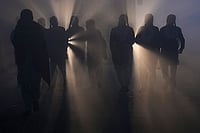As the final countdown to the new year reverberates, a familiar melody rises from a chorus of millions across the globe. "Should auld acquaintance be forgotten, and never brought to mind?" asks "Auld Lang Syne," the song inextricably linked to New Year's Eve rituals worldwide. But beneath the festive cheer and clinking glasses lies a story steeped in history, cultural nuances, and even controversies, unraveling the enduring legacy of this tradition.
From Burns' Quill to Hogmanay's Heart: Birthing a Song of Time and Tide
The journey of "Auld Lang Syne" unfolds not under the dazzling lights of Times Square, but in the quiet Scottish countryside. In 1788, poet Robert Burns, deeply inspired by an older folk poem and melody, penned his own version, capturing the bittersweet sentiment of reflecting on the past while embracing the unknown future. The evocative phrase "auld lang syne," translating to "old long since," embodies a nostalgic yearning for times gone by and the enduring connections woven through them.
While Burns' words resonated deeply with Scots, it wasn't until the 19th century that "Auld Lang Syne" found its true New Year's Eve calling. Scottish emigrants carried their traditions across the globe, including the custom of singing the song during Hogmanay, the boisterous Scottish New Year's Eve celebration. Over time, this practice intertwined with existing New Year's Eve rituals in other cultures, gaining widespread popularity in the United States through strong Scottish American communities.
Auld Lang Syne: Embraced, Questioned, and Reinvented
But the ascent of "Auld Lang Syne" to global icon wasn't unaccompanied by critical whispers. Some find its lyrics dated and overly sentimental, questioning its vague nostalgia and potential for misinterpretations under the influence of New Year's Eve revelry. Critics also point to the Eurocentric dominance of the song, overlooking the richness of other cultural expressions of new year reflection.
Yet, despite these objections, "Auld Lang Syne" endures. Its simple melody, universal theme of human connection, and the ritualistic act of collective singing imbue the song with a powerful magic. It becomes a moment of shared vulnerability, where strangers become kin, reflecting on a year gone by and taking a collective leap into the vast unknown.
In a world increasingly fractured and hyperconnected, "Auld Lang Syne" offers a rare moment of unity. It transcends language and cultural barriers, reminding us of our shared humanity and the threads that bind us across time and space. The act of singing becomes a symbolic communion, a collective sigh of farewell to the departing year and a hopeful embrace of the one to come.
Beyond Tradition's Threshold: Modern Melodies and A Future Chorus
Even today, "Auld Lang Syne" continues to evolve. Contemporary artists reinterpret its timeless melody, injecting new styles and sensibilities while preserving its core message. From rock renditions to pop mashups, the song adapts to the times, demonstrating its enduring relevance and capacity for reinvention.
So, as the clock strikes midnight and the world joins hands to sing "Auld Lang Syne," remember that it's more than just a tradition. It's a toast to memories, a promise of new beginnings, and a universal expression of our shared human journey. The song asks us the poignant question: "Should auld acquaintance be forgot?" And perhaps, in the act of raising our voices together, we find the answer – no, they should not, for they live on in the tapestry of our stories, the echoes of our laughter, and the hope we carry for the year to come.



























